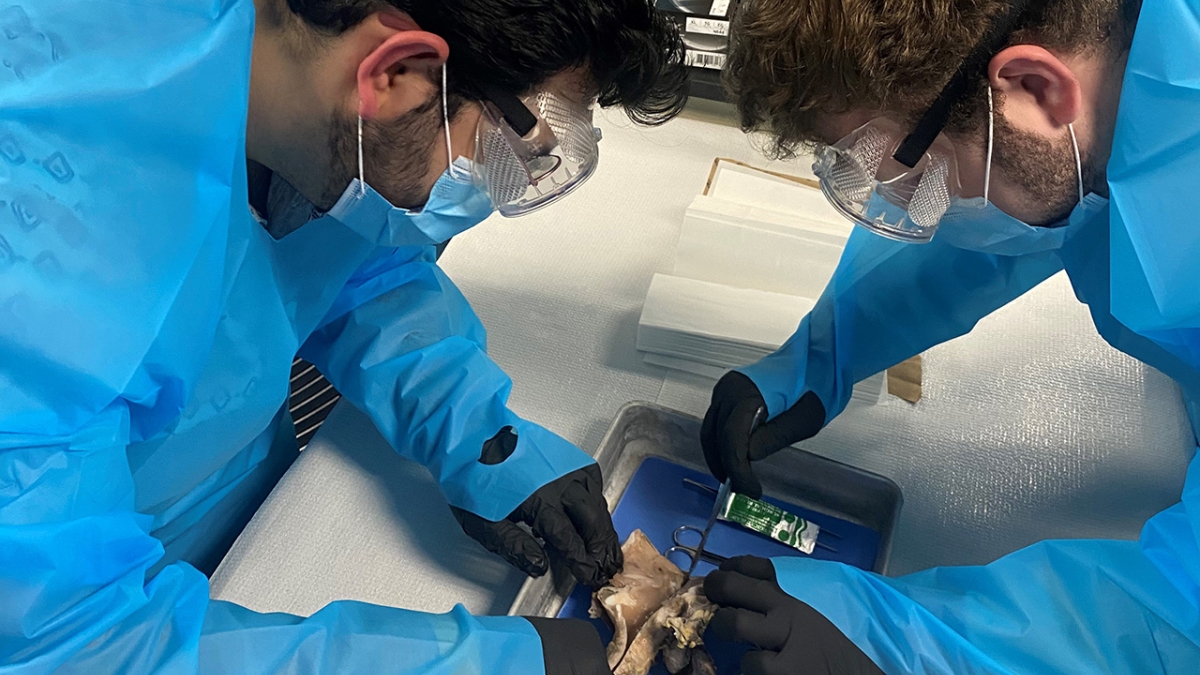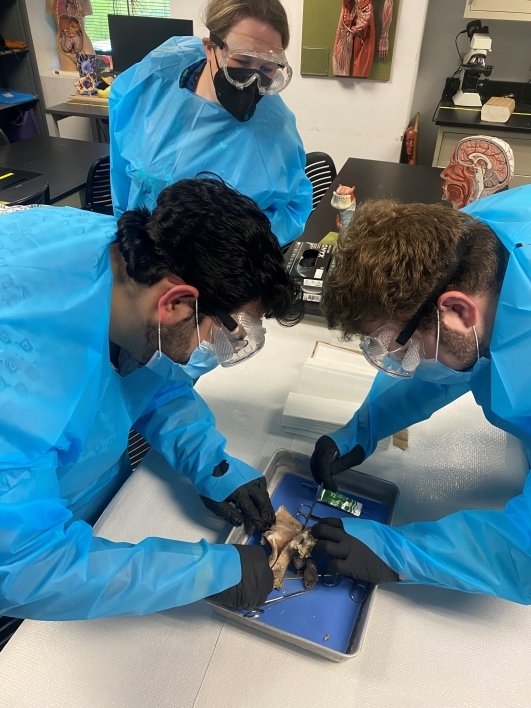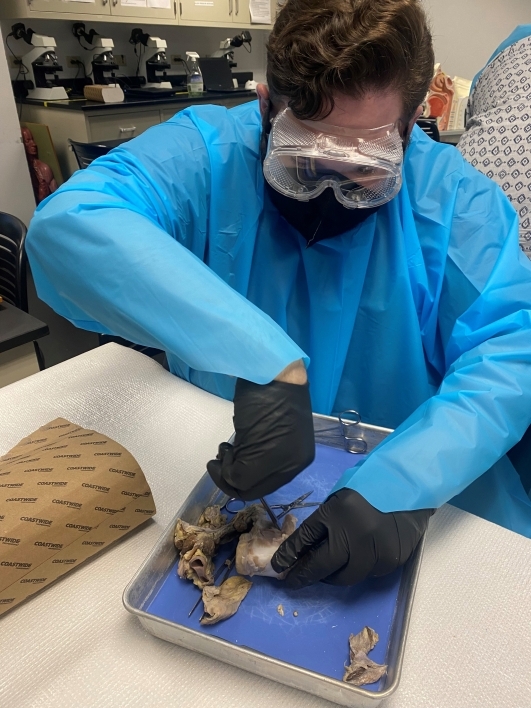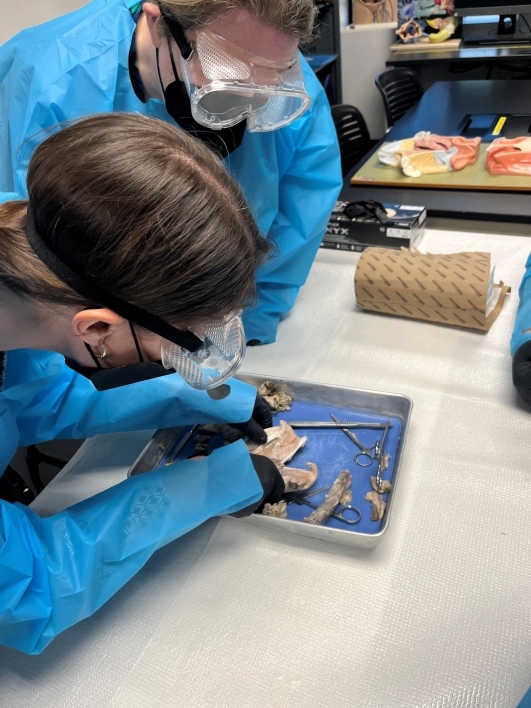ASU voice professor connects music, science during field trip for grad students

Two voice performance students dissect a sheep's larynx. Photo by Amanda DeMaris
Graduate-level voice performance and voice performance pedagogy students in the School of Music, Dance and Theatre recently participated in a field trip for a hands-on experience to dissect and explore the different parts of the body associated with singing.
Amanda DeMaris, clinical assistant professor of voice, took five students in her Anatomy and Physiology of Singing class to a lab in the science, mathematics and social science program at the College of Integrative Sciences and Arts on the Downtown Phoenix campus.
DeMaris said that while the students are always doing hands-on learning and practical application of topics in the teaching components of their vocal pedagogy classes, this was the first time that she exposed them to this type of experience.
“The voice can be a complicated instrument to teach, in part because our instrument is within us,” DeMaris said. “I thought that this opportunity would help deepen the students' understanding of the anatomy of the voice, and in turn have a positive effect on their teaching.”
Joining DeMaris and her class was Stephanie Weiss, associate professor of voice, who is frequently guest lecturer for the class. Weiss said she has used 2D and 3D diagrams and videos, but the hands-on experience was also a first for her.
DeMaris said the inspiration for the field trip came from colleague Andrea Pitman Will, voice instructor and ASU alumna, who mentioned that a visit to a campus cadaver lab through her vocal pedagogy class had a huge positive impact.
After researching available resources for a similar experience, DeMaris discovered the Anatomage Table, or digital cadaver, housed in the College of Integrative Sciences and Arts, and planned a tour and hands-on experience.
The lab coordinator, Christopher Gozo, took the students through the dissection of a sheep's larynx, as the structure is similar to that of a human. Through the dissection process, students were able to feel the texture of the cartilage and muscles. They also viewed cadaver specimens of a human head and human lungs and were guided through the interactive Anatomage Table that allowed them to dissect parts of the cadaver images, practice identifying the elements of the voice and see them in scale to the rest of the human body.
DeMaris said the experience provided benefits unavailable from classroom work, such as getting to know the anatomy and physiology of the singing voice. Pictures, video and models are also helpful, she said, to solidy the ability to identify and understand all of the working parts.
Bille Bruley, doctoral student in voice performance, described the experience as “amazing, incredibly enriching, helpful and fascinating.”
“My favorite part of the visit was the dissection of the sheep larynx,” Bruley said, “Although a little different than the human larynx, we were able to physically and tangibly see the inner workings of the small but complex laryngeal mechanism, and identify, question and discover all of the things we’ve been learning.”
Weiss described the experience as a huge benefit to the learning process that vividly enhances and builds on regular classroom learning. Because the students can see real specimens and visualize the anatomical structures, she said, it solidifies their understanding.
“I would definitely do this again,” Weiss said. “It is wonderful that we have access to this lab, and I hope that we can use it more in the future, as it made all of the theoretical concepts from the diagrams in the books come to life.”
DeMaris and Weiss both said they hoped that, through this experience, the students will better retain the course material and be motivated and inspired to continue their study of anatomy and physiology to deepen their understanding of how the vocal instrument works.
DeMaris said since the students had such a positive experience, she plans to incorporate more of these types of field trips in future classes.
DeMaris and Weiss said future collaborations with the College of Integrative Sciences and Arts and the speech and hearing department in the College of Health Solutions are being planned to provide learning opportunities for voice and vocal pedagogy students.
“The collaboration between our two departments was very special, and getting to talk to students and professors from the medical side of what we study was simply amazing,” Bruley said. “We all have things we can learn from others, especially others that study the same thing from very different perspectives. We were learning from their department while they were learning from ours at the same time. That was the best part of this visit ... true collaboration.”
More Science and technology

Science meets play: ASU researcher makes developmental science hands-on for families
On a Friday morning at the Edna Vihel Arts Center in Tempe, toddlers dip paint brushes into bright colors, decorating paper…

ASU water polo player defends the goal — and our data
Marie Rudasics is the last line of defense.Six players advance across the pool with a single objective in mind: making sure that…

Diagnosing data corruption
You are in your doctor’s office for your annual physical and you notice the change. This year, your doctor no longer has your…




